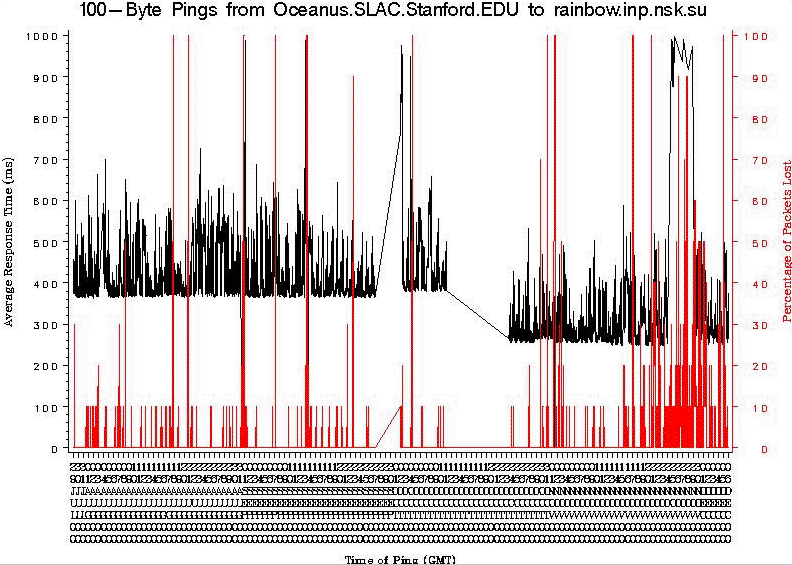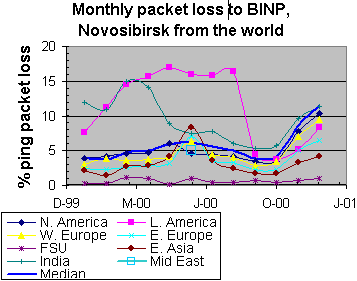Network connectivity between SLAC and BINP, Novosibirsk

Les Cottrell.
Page created: December 6, 2000.
Central Computer Access | Computer Networking | Network Group | ICFA-NTF Monitoring
|
|
Network connectivity between SLAC and BINP, Novosibirsk
Les Cottrell.
Page created: December 6, 2000.
|
|
According to email from Serge Belov of BINP sent December 8, 2000:
- The main channel is based on 128K link BINP-kek leased from Rostelecom and Japantelecom. This link works almost fine. Connectivity to SLAC and some other DOE sites is provided by our KEK colleagues as our tiny 128K could not overload their at least T1 connection between KEK and SLAC. Unfortunately that part of the whole route is working not so stable and we've observed some troubles even this November. - Alternative route is based on 700K satyellite link BINP - DESY. The main problem here is that this link is used also by many organizations of Novosibirsk Scientific Center, so our share is not more than 10%. Of course only small part of these 10% is available to BINP-SLAC exchange.


Yukio karita of KEK sheds some light on these losses in email to cottrell 12/11/00:
There were at least three troubles which affected SLAC's connectivity to BINP
since this October.
1) As you know, the contractor for the NII(NACSIS)'s external links was
changed from KDD to NTT on 1 October. NII's POP in USA is located at NTT
San Jose Office. NII's USA link has a capacity of more than 300Mbps.
A 10Mbps ATM PVC connecting KEK and ESnet Sunnyvale POP was created within
it. (ESnet Sunnyvale POP to NII SanJose POP is made with a DS3 circuit
prepared by Jim Leighton.)
The transition was made almost smoothly, however there were some breaks
several times. KEK's connectivity to ESnet was backed up by the APAN.
However this back up doesn't work for the BINP-ESnet connectivity.
Attached at the end of this mail is a mail which I sent to routing@es.net,
where I requested to create an IP tunnel for KEK and ESnet to peer over the
APAN link. This IP tunnel is to provide a back up route for the ESnet-BINP
connectivity. However I haven't received any response from routing@es.net
so far.
2) We had some trouble at our Fore-ASX200BX, where the ESnet-KEK ATM PVC is
terminated. It took place at about 10:00 on 24 Novermber JST, and was
fixed at about 16:00 on 29 November JST. The KEK-ESnet PVC was not
available then. KEK's connectivity to ESnet was backed up by the APAN,
while BINP's connectivity to ESnet was not backed up.
3) Some miss configuration was made in NII's domestic ATM backbone at about
8:00 on 21 November JST. It introduced a high rate of ATM cell losses.
It affected the KEK-ESnet PVC too. The miss configuration was fixed at
about 10:00 on 4 December JST.
- The main direction of improving the connectivity between our sites should be either expanding that existing BINP-KEK channel upto, say, 512K - if our KEK colleagues are agree - or establishing another dedicated link Novosibirsk - SLAC. Currently both options are being considered and evaluated, but I can't provide you with any kind of time schedule.Email from Yukio Karita, KEK on 12/11/00:
We are also very interested in getting higher speed/quality to BINP, and have been discussing it with Japan Telecom. The difficulty is in budgeting the Russian half circuit. BINP once said to me that they would try to get the budget for 1.5Mbps from the Academy, but no good news has come yet. So if USA side can help BINP for the Russian half circuit, it might be a good solution. I believe KEK can pay for the Japanese half circuit. An 1.5Mbps leased line or an 1.5Mbps frame relay might be good for the next step. I don't worry about the impact of the 1.5Mbps on the KEK-ESnet link. I believe it is not so difficult to get more bandwidth (on the link from KEK to the US) if needed. NII(NACSIS)'s bandwidth to USA from where our 10Mbps is obtained has been and is going to be doubled each year.Email from Serge Belov Dec 12, 2000 concerning upgrade costs (note these are the half circuit costs seen from the Russian end):
For the current scheme with transit through KEK 512K link will cost 10,350K$ monthly (Rostelecom prices) for international part and much less for local loop - about 500$ per month.
One time payments are estimated to be similar to installation cost for a new channel, that is about 1K$ (this includes testing, wiring, commutation etc).
This upgrade is possible with already installed E1 equipment where we will thus consume 1,536Kbps and will have spare 512K that should be reserved for our Moscow connectivity (which in turn also needs to be upgraded by at least 512K).
More serious upgrade (upto mentioned T1) will require installation of additional equipment - WAN Interface Card for this Cisco (800$) and the pair of HDSL modems - total about 2K$ plus some time for delivering this things and connecting all this together.
In this case monthly payments could be about 20K$ for intnl part plus something around 500$ for local loop.
The variant with another dedicated link BINP-SLAC seems actually not necessary provided KEK agreed with first scheme.
As I was informed Rostelecom already was requested by Japan Telecom to consider this upgrade and the only problem will be to find funding for this project. This is the most uncertain topic.